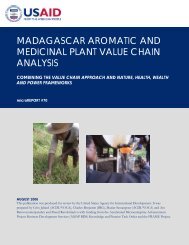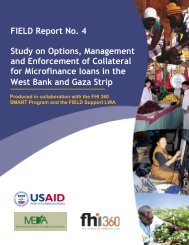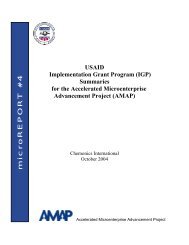End Market Analysis of Ethiopian Livestock and ... - USAID Microlinks
End Market Analysis of Ethiopian Livestock and ... - USAID Microlinks
End Market Analysis of Ethiopian Livestock and ... - USAID Microlinks
Create successful ePaper yourself
Turn your PDF publications into a flip-book with our unique Google optimized e-Paper software.
IV. COMPETITORS<br />
Ethiopia’s main competitors in the Middle East live animal market are Australia for sheep <strong>and</strong> Somalia for sheep <strong>and</strong><br />
goats. The primary competitors in the meat market Brazil <strong>and</strong> India for beef, <strong>and</strong> Australia <strong>and</strong> New Zeal<strong>and</strong> for<br />
sheep meat. Pakistan is also an increasingly important exporter <strong>of</strong> chilled beef.<br />
Note: In this chapter, the term “Middle East” will be used to describe the major market countries for each type <strong>of</strong><br />
meat. Therefore, for beef, the Middle East will comprise Bahrain, Egypt, Kuwait, Oman, Qatar, Saudi Arabia <strong>and</strong> the<br />
UAE. For sheep <strong>and</strong> goats, the Middle East will comprise Bahrain, Kuwait, Oman, Qatar, Saudi Arabia <strong>and</strong> the UAE.<br />
Unless otherwise indicated, export statistics reported in this chapter were obtained from UN COMTRADE.<br />
A. LIVE ANIMALS<br />
1. AUSTRALIA<br />
Australia is the world’s leading live sheep exporter. In 2007-2008, Australia exported over 4 million head <strong>of</strong> live sheep,<br />
<strong>of</strong> which 97 percent went to the Middle East. 79 Australia holds a significant portion <strong>of</strong> the Middle East market: in<br />
2008/09, Australia had 23 percent <strong>of</strong> the market share in the major live sheep markets <strong>of</strong> Saudi Arabia <strong>and</strong> Kuwait, 19<br />
percent <strong>of</strong> the market share in Bahrain, 14 percent <strong>of</strong> the Oman market, 8 percent <strong>of</strong> the Qatar <strong>and</strong> Jordan markets<br />
<strong>and</strong> 4 percent <strong>of</strong> the UAE market.<br />
EXPORT TRENDS<br />
After virtually no live sheep exports to Saudi Arabia throughout the 1990s, Australian exports went from zero in<br />
1998/99 to over 2 million in 2001/02 <strong>and</strong> 2002/03, ostensibly replacing imports from the Horn <strong>of</strong> Africa, which were<br />
halted by the RVF ban imposed by KSA. Exports were low again in 2003/04 <strong>and</strong> 2004/05 (likely due to Australia’s<br />
severe drought in 2003), but rose again <strong>and</strong> have been above or near 1 million head every year since 2005/06,<br />
although they decreased again in 2007/08. Exports to Kuwait grew steadily from the mid-1990s to 2002, then<br />
plateaued <strong>and</strong> dropped to 1 million head or fewer starting in 2004/05 (MLA 2009). Exports to Bahrain have grown<br />
steadily from approximately 120,000 head in 1990/91 to 775,000 head in 2008/09. Exports to Qatar <strong>and</strong> Oman are<br />
lower but generally on the rise after a drop from 2002 to 2005.<br />
PRICE TRENDS<br />
The price <strong>of</strong> Australian sheep has more than doubled in the last decade, from $24/head FOB in 1999/2000 to<br />
$53/head FOB in 2008/09.<br />
SEASONALITY<br />
Australian sheep exports to Saudi Arabia peak in May <strong>and</strong> June, leaving the peak October-December (end <strong>of</strong><br />
Ramadan/Hajj period) open to other suppliers.<br />
Meat <strong>and</strong> <strong>Livestock</strong> Australia (MLA) has had a regional marketing <strong>of</strong>fice in the region for over 30 years. Located in<br />
Bahrain, the MLA conducts market research to help Australian producers <strong>and</strong> exporters better underst<strong>and</strong> end market<br />
requirements <strong>and</strong> promotes Australian meat in accordance with consumer preferences <strong>and</strong> quality st<strong>and</strong>ards.<br />
79 MLA 2008<br />
END MARKET ANALYSIS OF ETHIOPIAN LIVESTOCK AND MEAT 29





